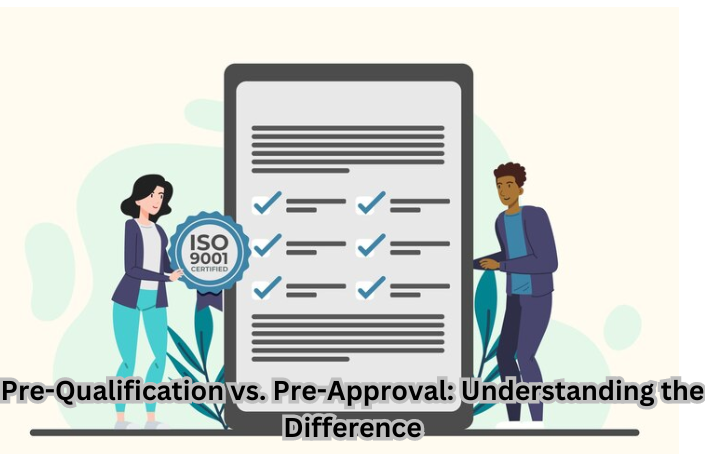Pre-Qualification vs. Pre-Approval: Understanding the Difference
People often use “pre-qualification” and “preapproval” to get a mortgage or loan. Even though these words sound alike, they mean different things regarding loans. It is essential for people who want to buy a house or get a loan to know the difference between pre-qualification and preapproval. Let’s examine these terms to see their meaning and how they affect your financial journey. Click here..
Looking at the Basics of Pre-Qualification
The first step in getting a mortgage or loan is getting prequalified. Casually, it looks at your cash situation. This is the first step in getting a loan. You tell the lender about your income, bills, and belongings. The investor looks at this information to understand how much you can borrow. This evaluation usually doesn’t look into your credit record in great detail or do a complete analysis.

Exploring the nuances of Pre-Qualification vs. Pre-Approval in the journey towards your financial goals
Getting the Process Right
Most of the time, you were getting prequalified means talking to a banker or filling out an online form. They estimate how much of a loan you can get based on the information you give them. It’s important to remember that getting prequalified doesn’t mean you’ll be approved or the loan will lend you the money.
Most Important Pros and Cons
There are some excellent things about pre-qualification. It’s easy, quick, and doesn’t need a hard credit check. This process gives you a first look at how much you can borrow, which can help you start looking for a house or making plans for your finances. However, because it’s based on unconfirmed information, the loan amount you can get may differ when you start the official application process.
A Deeper Dive Before Approval
In contrast to pre-qualification, preapproval includes a more thorough and official check of your financial situation. You must fill out a legal mortgage application as part of this process. You must show proof of your income, such as pay stubs, tax records, bank bills, and permission for a credit check.
How the Evaluation Works
During preapproval, lenders look closely at your credit history, income, assets, and bills. They check the information you give them and look at your credit score to figure out how much they’re ready to lend you. Preapproval is a better sign of your ability to borrow money because it is based on accurate data instead of guesses.
Pros and Cons and Why They Matter
The best thing about preapproval is that it gives you confidence. When you’re house shopping, having a preapproval letter makes you look like a more serious buyer. It lets buyers know you can afford the house and gives you more negotiation power. Preapproval also helps you set a reasonable budget, saving you time because you can only look at homes within your accepted loan amount.

Deciphering the nuances: Pre-Qualification vs. Pre-Approval. Your roadmap to confident financial decisions
What Makes Pre-Qualification and Preapproval Different?
Pre-Qualification:
- Data Collection: Informal gathering of basic financial information like income, assets, and debts.
- Assessment: Based on self-reported data without verification or a credit check.
- Purpose: Provides an estimate of potential loan amounts, serving as an initial step.
Preapproval:
- Data Collection: Requires detailed documentation, including pay stubs, tax returns, bank statements, and consent for a credit check.
- Assessment: Involves a rigorous evaluation of verified data, credit history, and financial status.
- Purpose: Offers a specific loan amount that lenders are willing to provide, backed by a formal application process.
Proof and documentation
One big difference between pre-qualification and preapproval is how closely the application is looked at. For pre-qualification, information is self-reported, but for preapproval, documents must be checked. A credit check is done during preapproval but not during pre-qualification. This gives a more accurate picture of your financial situation.
Dependable and Sure Things
While pre-qualification gives you a rough idea of how much the loan will be, preapproval gives you a more solid and exact number. When you get pre-approved, you know that a lender will likely provide you with a certain amount of money as long as the property is appraised and you meet other screening requirements.
Making Smart Choices: Which One to Go For?
Whether you choose pre-qualification or preapproval depends on who is in the process and what your financial goals-cation is a great place to start when looking at your choices or making plans for your budget. However, getting preapproval would be better if you’re actively looking for a home or ready to make an offer.
In conclusion
Knowing the difference between pre-qualification and preapproval is essential when trying to get a mortgage or loan. Both are useful for different things and give you information about your ability to borrow money at other times. Preapproval is a more firm promise from lenders than pre-qualification, which gives you an idea. Knowing these differences will help you make intelligent choices and feel strong through the loan process. Pick the right road that fits your financial goals, and then you can start becoming a renter with confidence and clarity.
FAQ: Pre-Qualification vs. Preapproval
Navigating the labyrinth of mortgage applications or loan processes can be daunting. Among the many terms, “pre-qualification” and “preapproval” are critical initial steps. However, understanding the nuances between these terms is pivotal. Let’s explore the frequently asked questions to demystify the differences between pre-qualification and preapproval, empowering you to take confident steps toward your financial goals.
What is the difference between prequalified and preapproval?
Pre-Qualification:
- Overview: Pre-qualification is an initial assessment based on basic financial information provided by the borrower.
- Process: It involves a lender estimating the loan amount a borrower might qualify for based on self-reported income, assets, and debts.
- Verification: No verification or credit check is typically performed during pre-qualification.
- Reliability: It offers a rough estimate, but it’s not a commitment from the lender and doesn’t guarantee loan approval.
Preapproval:
- Overview: Preapproval is a more rigorous evaluation based on verified financial information.
- Process: It requires detailed documentation, including pay stubs, tax returns, and a credit check.
- Result: Provides a specific loan amount that a lender is willing to offer, backed by a formal application process.
- Reliability: It represents a firm commitment from the lender, subject to property appraisal and other conditions.
How do you understand preapproval?
Preapproval:
- Understanding: Preapproval signifies a lender’s willingness to provide a specific loan amount.
- Process: It thoroughly assesses a borrower’s financial status, credit history, and documentation.
- Importance: Provides a solid foundation for house hunting, strengthening the buyer’s credibility and negotiating power.
- Reliability: Offers a reliable loan amount, aiding in setting realistic budgets and streamlining property searches within approved loan limits.
What is the difference between preselected and pre-approved?
Preselected:
- Overview: Being preselected typically refers to receiving an offer or invitation from a lender or credit issuer.
- Meaning: It implies that individuals are eligible for a financial product or service based on initial criteria, such as credit score.
- Commitment: Being preselected doesn’t guarantee approval; it’s more of an invitation to apply.
Pre-Approved:
- Overview: Preapproval involves a thorough evaluation by a lender based on verified financial information.
- Meaning: It signifies a lender’s commitment to provide a specific loan amount, subject to certain conditions.
- Reliability: Offers a more concrete commitment than being preselected and is based on a more detailed assessment of financial eligibility.
What’s the difference between preapproval and final approval?
Preapproval:
- Nature: Preapproval is an initial stage in the mortgage or loan process.
- Commitment: It signifies a lender’s willingness to provide a specific loan amount, subject to conditions like property appraisal.
- Reliability: Offers a reliable estimate but is not the final approval for the loan.
Final Approval:
- Nature: Final approval occurs after the property is appraised and all underwriting conditions are met.
- Process: It thoroughly assesses the property and ensures all borrower conditions are fulfilled.
- Result: Represents the lender’s final commitment to extend the loan, considering the property’s value and meeting all criteria.




Post Comment